#Data Engineering Components
Explore tagged Tumblr posts
Text
Understanding Core Components of the Data Engineering Ecosystem | Brilliqs

Explore the foundational components that power modern data engineering—from cloud computing and distributed platforms to data pipelines, Java-based workflows, and visual analytics. Learn more at www.brilliqs.com
#Data Engineering Ecosystem#Data Engineering Components#Cloud Data Infrastructure#Apache Spark#Amazon QuickSight#Data Pipelines#Data Management#Java for Data Engineering#Brilliqs
1 note
·
View note
Text
Front Brake Speed Sensor Kits for Drag Racing – Strange Engineering

Drag racing is a competitive sport, and using quality adjustment tools is crucial to staying ahead of your competition. Small adjustments need to be made carefully in the car so that it can provide the maximum benefits in the competition. Front Brake Speed Sensor Kit is one of those important small adjustments that should not be neglected. This component plays an important role in providing stability to the driver while doing drag racing.
The Value of Front Wheel Data
Drag racing isn’t just about speed—it’s about control and consistency. Most racers are familiar with rear wheel sensors, but adding a sensor to the front brakes offers unique insights. These kits track front wheel rotation during launch and braking, offering data that helps diagnose traction issues, brake timing, and suspension behavior.
This forward-looking approach allows teams to understand how their cars behave at the most critical points of a run. Without it, you're missing half the story.
Designed for the Track, Built for Abuse
Race environments are punishing. Heat, high RPMs, vibration, and abrupt force changes mean that only the toughest components survive. That’s why selecting sensor kits designed for racing, not adapted from street vehicles, is crucial.
High-grade materials and motorsport-focused designs ensure these sensors can deliver clean, uninterrupted signals every run. From sealed wiring to strong mounting hardware, durability isn’t optional—it’s expected.
Installation and Compatibility Matter
A solid sensor is only as good as its installation. Alignment, spacing, and secure mounting are key to avoiding signal errors or component wear. Quality kits offer user-friendly setup options that work seamlessly with major data acquisition systems.
Once in place, a properly installed sensor kit will begin generating actionable insights immediately. Fewer adjustments, faster calibration, and better accuracy mean more time fine-tuning performance, and less time troubleshooting.
Smarter Data Leads to Smarter Decisions
What makes these kits so powerful is the ability to reveal patterns drivers can’t feel. For instance, consistent early deceleration on one wheel may indicate imbalance or hidden chassis issues. Without this feedback, teams might continue tuning around a problem they didn’t know existed.
By integrating this information with other data sources, teams can refine setup decisions that impact every launch, shift, and braking point.
Why Front Sensors Are Gaining Popularity
Front brake speed sensors have become more common in top-tier racing, not because of a trend, but because of results. Racers who embrace this technology often find themselves one step ahead—predicting problems, dialing in performance, and maintaining mechanical health better than those relying on guesswork.
With any racing tool, there is a matter of quality. Drag-specific kits tested in actual track conditions provide unparalleled reliability and value.
A Trusted Source for Race-Grade Components
This is where Strange Engineering continues to set the standard. Known for delivering parts that hold up under extreme pressure, they offer Front Brake Speed Sensor Kits that racers trust for performance and longevity. Whether you’re a weekend warrior or a seasoned pro, having dependable data from the front wheels can be the edge you’ve been missing.
Conclusion
When you're racing for every hundredth of a second, trusted feedback becomes very important for your progress. A front brake speed sensor kit is an investment, yes, but the insights it provides can be life-changing. In a sport where control is speed, it's the silent data that tends to speak the loudest.
#front brake speed sensor kit#drag racing brake sensors#Strange Engineering brake sensors#race car speed sensor kits#front wheel speed sensor#brake system sensor kit#drag car data acquisition#high-performance brake sensors#motorsports sensor kits#front brake monitoring#front brake speed sensor kits#drag racing brake speed sensors#Strange Engineering front brake sensor#race car front wheel sensor#brake system speed monitoring#drag racing data acquisition sensors#high performance racing sensors#front wheel data logging sensor#drag racing brake components#brake sensor kits for race cars
0 notes
Text
Humans entering space and realizing we are so small. We are mice compared to these giant races with their advanced machinery and technologies and experiences beyond us- except that we're humans. And our engineers dive into the new tech and once we learn the principles we also soon realize how Inefficient everything is. Their "microchips" are the size of cars, their storage drives are basically buildings, and they somehow store less data than ours. So, human companies take advantage, and tech starts rolling out. Massive and there's a lot of wasted space so that it can be managed with larger hands/pincers/claws/tentacles, but also so much more efficient than anything the galaxy has seen before.
Human technicians start hopping ships and upkeeping the general maintenance, the stuff that most aliens put off or don't notice because they never access the crevices of their ships. As human companies become more popular and lead the tech world in everything from warp cores to game stations ("it's so compact! How are the graphics so good?" Says a 60' tall grimbleback, holding a new VR headset that has all of its components included because it's so BIG by our tech standards), soon many things have accessibility ports for humans to be able to use as well. This means that these shiprats hoping ship to ship cause such a huge improvement in everything running smoothly, and there's a huge downtick in pests on ships because those "pests" are not only big enough and aggressive enough to bite a pitbull or a person in half, they're invasive to so many planets and humans hate nothing more than dog killing planet overrunning monsters.
All the while, from the Aliens perspective, humans are an elusive race that don't fraternize much with them. You almost never see a human as most places aren't exactly safe for the little things to run around in. They do export so much stuff though, and the custodial staff at the Central Galactic Outpost insists that there's more humans around than any other race if you just know where to look.
And sure it's somewhat known that some of the little daredevils hop ships and help out in exchange for room and board, usually without permission, but that can't be that common, can it?
Maybe your ship is running better this cycle ever since you stopped at the last station, that just means that tuneup was better than you thought. And maybe for some reason that program you were working on last night is finished when you wake up, but you're so tired maybe you finished it before you passed out. Somehow that faulty light in the galley has fixed itself as well, which is odd, but maybe the Engineer finally got to it. You'd know if there was someone else on your ship.
Right?
... You leave a little bowl of berries out as a thank you, just in case. You're not sure what humans like but you've heard they have a sweet tooth.
15K notes
·
View notes
Text
Essential Components of a Data Pipeline

Modern businesses utilize multiple platforms to manage their routine operations. It results in the generation and collection of large volumes of data. With ever-increasing growth and the use of data-driven applications, consolidating data from multiple sources has become a complex process. It is a crucial challenge to use data to make informed decisions effectively.
Data is the foundation for analytics and operational efficiency, but processing this big data requires comprehensive data-driven strategies to enable real-time processing. The variety and velocity of this big data can be overwhelming, and a robust mechanism is needed to merge these data streams. This is where data pipelines come into the picture.
In this blog post, we will define a data pipeline and its key components.
What is a Data Pipeline?
Data can be sourced from databases, files, APIs, SQL, etc. However, this data is often unstructured and not ready for immediate use, and the responsibility of transforming the data into a structured format that can be sent to data pipelines falls on data engineers or data scientists.
A data pipeline is a technique or method of collecting raw, unstructured data from multiple sources and then transferring it to data stores or depositories such as data lakes or data warehouses. But before this data is transferred to a data depository, it usually has to undergo some form of data processing. Data pipelines consist of various interrelated steps that enable data movement from its origin to the destination for storage and analysis. An efficient data pipeline facilitates the management of volume, variety and velocity of data in these applications.
Components Of A Scalable Data Pipeline
Data Sources: Considered as the origins of data. It could be databases, web services, files, sensors, or other systems that generate or store data.
Data Ingestion: Data must be collected and ingested into the pipeline from various sources. It would involve batch processing (periodic updates) or real-time streaming (continuous data flow). The most common tools for ingestion include Apache Kafka, Apache Flume, or cloud-based services like AWS Kinesis or Azure Event Hubs.
Data Transformation: As this data moves through the pipeline, it often needs to be transformed, cleaned, and enriched. Further, it would involve data parsing, filtering, aggregating, joining, and other operations. Tools like Apache Spark and Apache Flink or stream processing frameworks like Kafka Streams or Apache Beam are used.
Data Storage: Data is typically stored in a scalable and durable storage system after transformation. Common choices include data lakes (like Amazon S3 or Hadoop HDFS), relational databases, NoSQL databases (e.g., Cassandra, MongoDB), or cloud-based storage solutions.
Data Processing: This component involves performing specific computations or analytics on the data. It can include batch processing using tools like Hadoop MapReduce or Apache Spark or real-time processing using stream processing engines like Apache Flink or Apache Kafka Streams.
Data Orchestration: Managing data flow through the pipeline often requires orchestration to ensure that various components work together harmoniously. Workflow management tools like Apache Airflow or cloud-based orchestration services like AWS Step Functions can be used.
Data Monitoring and Logging: It's essential to monitor the health and performance of your data pipeline. Logging, metrics, and monitoring solutions like ELK Stack (Elasticsearch, Logstash, Kibana), Prometheus, or cloud-based monitoring services (e.g., AWS CloudWatch) help track and troubleshoot issues.
Data Security: Ensuring data security and compliance with regulations is crucial. Encryption, access controls, and auditing mechanisms are essential to protect sensitive data.
Scalability and Load Balancing: The pipeline should be designed to handle increasing data volumes and traffic. Horizontal scaling, load balancing, and auto-scaling configurations are essential to accommodate growth.
Fault Tolerance and Reliability: Building fault-tolerant components and incorporating redundancy is critical to ensure the pipeline continues to operate in the event of failures.
Data Quality and Validation: Implement data validation checks and quality assurance measures to detect and correct errors in the data as it flows through the pipeline.
Metadata Management: Managing metadata about the data, such as data lineage, schema evolution, and versioning, is essential for data governance and maintaining data integrity.
Data Delivery: After processing, data may need to be delivered to downstream systems, data warehouses, reporting tools, or other consumers. This can involve APIs, message queues, or direct database writes.
Data Retention and Archiving: Define policies for data retention and archiving to ensure data is stored appropriately and complies with data retention requirements and regulations.
Scaling and Optimization: Continuously monitor and optimize the pipeline's performance, cost, and resource utilization as data volumes and requirements change.
Documentation and Collaboration: Maintain documentation that outlines the pipeline's architecture, components, and data flow. Collaboration tools help teams work together on pipeline development and maintenance.
Conclusion
These components of a data pipeline are essential for working with big data. Understanding these components and their role in the data pipeline makes it possible to design and build efficient, scalable, and adaptable systems to the changing needs. You can get the help of a specialist company that offers services for data engineering to help design and build systems for data collection, storage and analysis.
0 notes
Text
25 Years of Exploring the Universe with NASA's Chandra Xray Observatory

Illustration of the Chandra telescope in orbit around Earth. Credit: NASA/CXC & J. Vaughan
On July 23, 1999, the space shuttle Columbia launched into orbit carrying NASA’s Chandra X-ray Observatory. August 26 marked 25 years since Chandra released its first images.
These were the first of more than 25,000 observations Chandra has taken. This year, as NASA celebrates the 25th anniversary of this telescope and the incredible data it has provided, we’re taking a peek at some of its most memorable moments.
About the Spacecraft
The Chandra telescope system uses four specialized mirrors to observe X-ray emissions across the universe. X-rays that strike a “regular” mirror head on will be absorbed, so Chandra’s mirrors are shaped like barrels and precisely constructed. The rest of the spacecraft system provides the support structure and environment necessary for the telescope and the science instruments to work as an observatory. To provide motion to the observatory, Chandra has two different sets of thrusters. To control the temperatures of critical components, Chandra's thermal control system consists of a cooling radiator, insulators, heaters, and thermostats. Chandra's electrical power comes from its solar arrays.
Learn more about the spacecraft's components that were developed and tested at NASA’s Marshall Space Flight Center in Huntsville, Alabama. Fun fact: If the state of Colorado were as smooth as the surface of the Chandra X-ray Observatory mirrors, Pike's Peak would be less than an inch tall.

Engineers in the X-ray Calibration Facility at NASA’s Marshall Space Flight Center in Huntsville, Alabama, integrating the Chandra X-ray Observatory’s High-Resolution Camera with the mirror assembly, in this photo taken March 16, 1997. Credit: NASA
Launch
When space shuttle Columbia launched on July 23, 1999, Chandra was the heaviest and largest payload ever launched by the shuttle. Under the command of Col. Eileen Collins, Columbia lifted off the launch pad at NASA’s Kennedy Space Center in Florida. Chandra was deployed on the mission’s first day.

Reflected in the waters, space shuttle Columbia rockets into the night sky from Launch Pad 39-B on mission STS-93 from Kennedy Space Center. Credit: NASA
First Light Images
Just 34 days after launch, extraordinary first images from our Chandra X-ray Observatory were released. The image of supernova remnant Cassiopeia A traces the aftermath of a gigantic stellar explosion in such captivating detail that scientists can see evidence of what is likely the neutron star.
“We see the collision of the debris from the exploded star with the matter around it, we see shock waves rushing into interstellar space at millions of miles per hour,” said Harvey Tananbaum, founding Director of the Chandra X-ray Center at the Smithsonian Astrophysical Observatory.

Cassiopeia A is the remnant of a star that exploded about 300 years ago. The X-ray image shows an expanding shell of hot gas produced by the explosion colored in bright orange and yellows. Credit: NASA/CXC/SAO
A New Look at the Universe
NASA released 25 never-before-seen views to celebrate the telescopes 25th anniversary. This collection contains different types of objects in space and includes a new look at Cassiopeia A. Here the supernova remnant is seen with a quarter-century worth of Chandra observations (blue) plus recent views from NASA’s James Webb Space Telescope (grey and gold).

This image features deep data of the Cassiopeia A supernova, an expanding ball of matter and energy ejected from an exploding star in blues, greys and golds. The Cassiopeia A supernova remnant has been observed for over 2 million seconds since the start of Chandra’s mission in 1999 and has also recently been viewed by the James Webb Space Telescope. Credit: NASA/CXC/SAO
Can You Hear Me Now?
In 2020, experts at the Chandra X-ray Center/Smithsonian Astrophysical Observatory (SAO) and SYSTEM Sounds began the first ongoing, sustained effort at NASA to “sonify” (turn into sound) astronomical data. Data from NASA observatories such as Chandra, the Hubble Space Telescope, and the James Webb Space Telescope, has been translated into frequencies that can be heard by the human ear.
SAO Research shows that sonifications help many types of learners – especially those who are low-vision or blind -- engage with and enjoy astronomical data more.
Click to watch the “Listen to the Universe” documentary on NASA+ that explores our sonification work: Listen to the Universe | NASA+

An image of the striking croissant-shaped planetary nebula called the Cat’s Eye, with data from the Chandra X-ray Observatory and Hubble Space Telescope. NASA’s Data sonification from Chandra, Hubble and/or Webb telecopes allows us to hear data of cosmic objects. Credit: NASA/CXO/SAO
Celebrate With Us!
Dedicated teams of engineers, designers, test technicians, and analysts at Marshall Space Flight Center in Huntsville, Alabama, are celebrating with partners at the Chandra X-ray Center and elsewhere outside and across the agency for the 25th anniversary of the Chandra X-ray Observatory. Their hard work keeps the spacecraft flying, enabling Chandra’s ongoing studies of black holes, supernovae, dark matter, and more.
Chandra will continue its mission to deepen our understanding of the origin and evolution of the cosmos, helping all of us explore the Universe.

The Chandra Xray Observatory, the longest cargo ever carried to space aboard the space shuttle, is shown in Columbia’s payload bay. This photo of the payload bay with its doors open was taken just before Chandra was tilted upward for release and deployed on July 23, 1999. Credit: NASA
Make sure to follow us on Tumblr for your regular dose of space: http://nasa.tumblr.com
2K notes
·
View notes
Text
What is Dataflow?
This post is inspired by another post about the Crowd Strike IT disaster and a bunch of people being interested in what I mean by Dataflow. Dataflow is my absolute jam and I'm happy to answer as many questions as you like on it. I even put referential pictures in like I'm writing an article, what fun!
I'll probably split this into multiple parts because it'll be a huge post otherwise but here we go!
A Brief History

Our world is dependent on the flow of data. It exists in almost every aspect of our lives and has done so arguably for hundreds if not thousands of years.
At the end of the day, the flow of data is the flow of knowledge and information. Normally most of us refer to data in the context of computing technology (our phones, PCs, tablets etc) but, if we want to get historical about it, the invention of writing and the invention of the Printing Press were great leaps forward in how we increased the flow of information.
Modern Day IT exists for one reason - To support the flow of data.
Whether it's buying something at a shop, sitting staring at an excel sheet at work, or watching Netflix - All of the technology you interact with is to support the flow of data.
Understanding and managing the flow of data is as important to getting us to where we are right now as when we first learned to control and manage water to provide irrigation for early farming and settlement.
Engineering Rigor
When the majority of us turn on the tap to have a drink or take a shower, we expect water to come out. We trust that the water is clean, and we trust that our homes can receive a steady supply of water.
Most of us trust our central heating (insert boiler joke here) and the plugs/sockets in our homes to provide gas and electricity. The reason we trust all of these flows is because there's been rigorous engineering standards built up over decades and centuries.

For example, Scottish Water will understand every component part that makes up their water pipelines. Those pipes, valves, fitting etc will comply with a national, or in some cases international, standard. These companies have diagrams that clearly map all of this out, mostly because they have to legally but also because it also vital for disaster recovery and other compliance issues.
Modern IT
And this is where modern day IT has problems. I'm not saying that modern day tech is a pile of shit. We all have great phones, our PCs can play good games, but it's one thing to craft well-designed products and another thing entirely to think about they all work together.
Because that is what's happened over the past few decades of IT. Organisations have piled on the latest plug-and-play technology (Software or Hardware) and they've built up complex legacy systems that no one really knows how they all work together. They've lost track of how data flows across their organisation which makes the work of cybersecurity, disaster recovery, compliance and general business transformation teams a nightmare.

Some of these systems are entirely dependent on other systems to operate. But that dependency isn't documented. The vast majority of digital transformation projects fail because they get halfway through and realise they hadn't factored in a system that they thought was nothing but was vital to the organisation running.
And this isn't just for-profit organisations, this is the health services, this is national infrastructure, it's everyone.
There's not yet a single standard that says "This is how organisations should control, manage and govern their flows of data."
Why is that relevant to the companies that were affected by Crowd Strike? Would it have stopped it?
Maybe, maybe not. But considering the global impact, it doesn't look like many organisations were prepared for the possibility of a huge chunk of their IT infrastructure going down.
Understanding dataflows help with the preparation for events like this, so organisations can move to mitigate them, and also the recovery side when they do happen. Organisations need to understand which systems are a priority to get back operational and which can be left.
The problem I'm seeing from a lot of organisations at the moment is that they don't know which systems to recover first, and are losing money and reputation while they fight to get things back online. A lot of them are just winging it.
Conclusion of Part 1
Next time I can totally go into diagramming if any of you are interested in that.
How can any organisation actually map their dataflow and what things need to be considered to do so. It'll come across like common sense, but that's why an actual standard is so desperately needed!
789 notes
·
View notes
Text
WASHINGTON (Reuters) - U.S. President Donald Trump’s 25% auto tariffs will cover nearly $600 billion worth of vehicles and auto parts imports annually and extend to all computer imports into the U.S. - including laptops - according to a Reuters analysis of tariff codes included in a federal register notice on Wednesday. The update of Trump’s auto tariff proclamation from last week included nearly 150 auto parts categories that will face tariffs starting on May 3, a month after Thursday’s midnight activation of 25% tariffs on vehicle imports. The list includes tariff codes for engines, transmissions, lithium-ion batteries and other major components, along with less expensive parts including tires, shock absorbers, spark plug wires and brake hoses. But a major surprise was the inclusion of the four-digit tariff code covering all computers, which are among the biggest global import categories into the U.S. at $138.5 billion in 2024, according to U.S. Census Bureau data.
america is about to get a drastic and sudden lesson on economics
186 notes
·
View notes
Note
She’s a Ferrari engineer and different people in the paddock can see how down bad Toto is for her every time they interact.
Downshift
back to my main masterlist
pairing: toto wolff x ferrari engineer (OC)
summary: toto wolff’s efficiency is legendary. His focus, unwavering. Until she arrives in the paddock as Ferrari’s newest engineer, and everyone starts noticing how he suddenly seems… distracted.
warnings: romantic tension, open ending


The paddock was alive with its usual hum of activity, journalists darting from one garage to another, engineers poring over data, and drivers engaging in last-minute interviews. It was a world of precision, discipline, and focus. Toto Wolff was the embodiment of all three.
Or at least, he had been.
The first meeting of the weekend started like any other: strategy briefs, discussions about weather conditions, and subtle jabs traded between rival teams. But today, something felt different. Toto wasn’t his usual commanding self. He wasn’t distracted by the numbers or even Christian Horner’s persistent prodding. No, his attention was elsewhere.
Her.
She was Ferrari’s newest addition, a sharp-minded engineer whose reputation for innovation had preceded her arrival. As she spoke, the room seemed to narrow, her words slicing through complex issues with ease. She didn’t just command respect, she demanded it. And Toto, much to his dismay, couldn’t look away.
—Wolff. —Horner’s voice broke through the discussion. —any thoughts?
Toto blinked, his focus snapping back. —It’s a solid plan. —he said quickly, his tone as measured as ever. But Lewis Hamilton, seated nearby, caught the faintest crack in his composure.
As the meeting ended and the attendees filed out, Lewis leaned in. —You good, boss? —he asked, his voice low. —You looked… distracted.
Toto straightened his tie, his expression impassive. —Focus on the race, Lewis.
But the day only got worse.
By mid-afternoon, the whispers had started.
—Did you see the way Wolff was watching her during the meeting?
—I’m telling you, he actually smiled. Toto Wolff smiled.
—Maybe he’s trying to poach her for Mercedes?
The rumors spread like wildfire, and Toto did little to dispel them. Every time he crossed paths with her, his usual cool demeanor seemed to falter. A second too long holding a door. A fleeting glance across the paddock. A barely-there smile when she passed by.
She noticed, of course. How could she not? She was sharp enough to catch the tension in his posture, the way his eyes lingered just a moment longer than necessary. And if she felt a twinge of satisfaction, she hid it well, burying it beneath a professional facade.
The real breaking point came during a rainy afternoon session. The rain had turned the pit lane into chaos. Engines roared, tires screeched, and mechanics scrambled to adapt. She was in the thick of it, crouched near the Ferrari garage with grease smudging her cheek as she adjusted a temperamental component.
Toto passed by, his stride slowing involuntarily. She looked up just as he did, their eyes locking for a split second. There it was again. That soft smile tugging at the corner of his mouth, the one that felt entirely out of place for someone as composed as him.
—Something caught your eye, Wolff? —Christian Horner’s voice interrupted, smug as ever. He was leaning against the Mercedes garage, arms crossed and a grin firmly in place.
Toto’s jaw tightened, his gaze flicking to Horner before he resumed walking. —Focus on your own team, Christian. —he said evenly, but the slight flush on his face didn’t go unnoticed.
Later that evening, the paddock had quieted, the storm outside matching the subdued atmosphere. She found herself alone in the Ferrari garage, organizing tools when she heard footsteps behind her.
—Toto. —she said without looking up, her voice tinged with amusement.
He froze, caught. —You’re very observant. —he admitted, stepping closer.
—I’d have to be, working in this world. —she replied, finally meeting his gaze. There was something playful in her eyes, a spark that set his nerves alight. —So, what can I do for you?
For a moment, he said nothing, his carefully constructed walls crumbling under the weight of her stare. Finally, he managed. —You’ve made quite an impression.
Her smile widened, slow and deliberate. —Have I? Because from what I hear, you’re the one making impressions, Toto.
He didn’t answer. He didn’t need to. The paddock had already done enough talking for both of them.
As he walked away, leaving her smirking in the quiet garage, Toto couldn’t shake the feeling that, for the first time in years, he was driving blind. And yet, he wasn’t sure he minded.
#totowolff x you#toto wolff x y/n#toto wolff fluff#toto wolff imagine#toto wolff fanfic#toto wolff x reader#fanfic#toto wolff#torger christian wolff
203 notes
·
View notes
Text
Singapore GP part 2
Masterlist
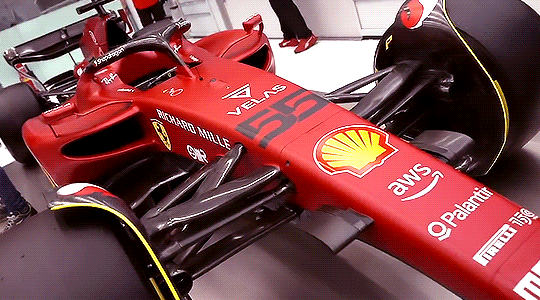
The sun bore down on the track as I settled into my car for Practice 3. The heat shimmered off the asphalt, making the circuit look like a mirage in the desert. My engineer’s voice came over the radio as I pulled out of the garage.
“Alright, let’s do a few race simulations. Keep it smooth, and let us know how the balance feels.”
The laps started off fine—steady pace, good feedback from the car. I was starting to feel the groove, envisioning how I’d attack certain corners during the race. But as I hit the apex of Turn 8, something felt... wrong.
“Uh, guys,” I said into the radio, frowning as I fought with the steering. “Something’s off. Feels like I’m losing power on the straights.”
“Copy that, we’re seeing it on the data. Box, box,” came the reply.
I limped back to the pit lane, frustration bubbling under the surface. By the time the mechanics started investigating, I was already out of the car, pacing near the monitors.
“It’s the ERS,” Marcus said after a tense ten minutes. “We’ll need to replace some components, but you’ll be fine for tomorrow.”
I nodded, exhaling sharply. I hated losing track time, especially during a session this crucial, but there wasn’t much I could do. As the minutes ticked by, I watched other drivers complete their runs, mentally taking notes while the mechanics worked on the car.
The next day, Qualifying loomed, and the pressure was palpable. By now, the car was fixed, and I was determined to make up for lost time.
Q1 was smooth—I managed to clock a competitive time and made it to Q2 without a hitch. The car felt sharp, responsive, almost like it was making up for yesterday’s troubles.
By the time we hit Q3, my nerves were a cocktail of excitement and determination. Every corner mattered now.
“Alright, let’s push,” my engineer said as I started my final flying lap.
The car danced through the corners, each turn feeling like an extension of myself. Sector one—purple. Sector two—green. I pushed harder through the final chicane, my tires squealing in protest as I crossed the line.
“P7,” my engineer said over the radio, his tone almost celebratory. “Great lap! Fernando is P6, this is a great look for the team.”
“What about Franco?”
“Franco in P12.”
I let out a breath I didn’t realize I’d been holding, a smile breaking across my face. P7. Not only was I starting in the top ten, but I’d qualified right behind my teammate.
As I climbed out of the car and waved to the fans, I caught sight of Fernando. He gave me a small nod of approval, a gesture that felt like a victory in itself, even if he wasn’t smiling.
Franco, on the other hand, was standing off to the side, shaking his head in mock disbelief when I passed him. “Alright, Hermosa,” he called out with a grin. “Don’t get too comfortable ahead of me.”
I laughed, the weight of yesterday’s frustration finally lifting. Tomorrow was race day, and I was ready to fight.
The city lights of Singapore reflected off the wet streets as the three of us stepped into a cozy restaurant tucked away from the chaos of the paddock. Franco had picked the spot, insisting that it was far enough from the main driver's haunts to avoid the usual media frenzy.
“Table for three,” Franco said with a charming grin as the host led us to a quiet corner.
I slid into the booth beside Lando while Franco took the seat opposite us. The tension from earlier—my battle in Qualifying, the weight of the weekend—started to melt away as the aroma of food filled the air.
“You know,” Lando began, glancing at me with a smirk, “you could’ve let Franco have P7. Would’ve been nice to have you further back so I wouldn’t have to worry about you at the start.”
I laughed, rolling my eyes. “Please, you got pole. Like I’m even in your mirrors.”
“Exactly my point!” Lando teased, and Franco chuckled as he picked up the menu.
As we settled into conversation, my gaze wandered across the restaurant. In the far corner, a table of familiar faces caught my attention—several other drivers were eating together, laughing and chatting like old friends. Fernando, Carlos, Pierre, Alex, and even Sergio were there. For a moment, I felt the sting of exclusion, but I tried to push it aside.
Franco noticed where my eyes had landed and cleared his throat. “You okay, Hermosa?”
I forced a smile. “Yeah, just... didn’t realize everyone else was here.”
“They always do this,” Lando said softly, his tone lacking its usual playfulness. “It’s kind of a thing. They keep it tight-knit, you know?”
I blinked, looking between the two of them. “You knew about this?”
Franco nodded, his expression serious. “We did. And we chose to be here instead.”
Lando leaned closer, his voice quieter but filled with sincerity. “Look, you don’t need them. They’re stuck in their little circle, and they don’t see what you do. You’re proving yourself every single weekend, and if they can’t see that, it’s on them.”
The lump in my throat threatened to choke me, but I managed a small smile. “Thanks, guys.”
Franco grinned, breaking the tension. “Enough of this sappy stuff. Let’s order before I starve.”
The night ended on a lighter note, filled with laughter and stories, the earlier sting of rejection fading as I realized that, with Franco and Lando by my side, I wasn’t entirely alone.
The humidity was oppressive as I sat in my car on race day, the grid bustling with activity. Lando was on pole, radiating confidence, while I prepared for the challenge ahead from P7.
The lights went out, and chaos erupted. I managed to hold my position through the first corner, but the car felt off almost immediately.
“Something’s not right,” I radioed in, fighting to keep control through Turn 5.
“Copy that,” my engineer replied. “We’re seeing it too. Keep pushing if you can; we’ll adjust strategy.”
For the next 15 laps, I wrestled the car, the balance off and the rear sliding unpredictably through the tighter corners. Drivers behind me loomed dangerously close, and I had to dig deep to keep them at bay.
Fernando, in P6, was a constant figure ahead of me. I could feel his presence as both a motivator and a challenge, his car tauntingly steady compared to mine.
Lap by lap, I fought back, leaning into the anger, the determination that had carried me this far. By the final stint, I found a rhythm, the car stabilizing enough for me to push.
When the checkered flag waved, I crossed the line in P6, a mix of exhaustion and relief washing over me.
“P6,” my engineer confirmed. “Well done, great recovery.”
As I rolled back into the pits, I caught sight of Lando climbing out of his car, his arms raised in victory. Pole to win—it was his day. But as he looked toward me, a smile broke across his face, and he gave me a thumbs-up.
Franco jogged over as I climbed out of my car, his grin as wide as ever. “See? I told you you’d survive. Now let’s go find Lando and celebrate.” I laughed, letting the tension of the race melt away.
Franco and I made our way through the bustling paddock, weaving through the sea of team personnel and media. The cheers from McLaren's garage were unmistakable, and it wasn’t hard to spot Lando—his beaming grin and the sea of orange-clad crew celebrating his victory made him stand out like a beacon.
“There’s our winner!” Franco called out, throwing an arm around Lando’s shoulders as soon as we reached him. “Pole to win, mate! And you were worried you’d choke!”
Lando laughed, shoving Franco lightly. “Please, I was never worried. Just making it look dramatic for you lot.”
“Sure you were,” I teased, stepping closer. “You looked ready to pass out on the grid.”
“I call that focus,” Lando shot back, sticking his tongue out before pulling me into a quick hug. “But seriously, thanks for coming. It means a lot.”
The celebration was warm and chaotic, with McLaren’s garage buzzing with energy. Oscar joined the group a few moments later, his quiet demeanor contrasting with Lando’s exuberance, but he was smiling nonetheless.
“Hey, Oscar,” Franco greeted with his usual charm, nudging me subtly. “You’ve met our girl here, right?”
Oscar nodded, his smile polite but genuine. “We’ve crossed paths a few times. Great job out there, by the way,” he said, glancing at me. “P6 with car troubles? That’s impressive.”
“Thanks,” I replied, genuinely surprised by his compliment.
“She’s been outdriving you for a while, mate,” Lando joked, earning a mock glare from his teammate.
“Careful,” Oscar warned playfully, “I’m still faster in the simulator.”
The banter flowed easily, and I found myself laughing along with them, the weight of the past few weeks easing with every joke and story shared.
At some point, Lando raised his drink—a bottle of water, still in full celebration mode but with tomorrow in mind. “To good races, great friends, and proving every doubter wrong.”
The four of us clinked our bottles together, the unspoken camaraderie cementing itself in the shared moment.
As the night wore on, I couldn’t help but notice how seamlessly Oscar fit into the dynamic. While quieter than Franco and Lando, he had a subtle wit that added to the conversation, and his genuine interest in getting to know me felt like a small but meaningful victory.
“Guess we’ve got a new regular for our dinner outings,” Franco remarked as we started to head out.
“Careful,” Lando quipped, “Oscar’s competitive. He might take over my friend spot.”
Oscar smirked. “Not a chance. I’m not sure I can handle both of you.”
We all laughed as we left the McLaren garage, the Singapore night alive with energy. For the first time in weeks, I felt like part of something bigger than just the race. It wasn’t about the rumors, the past, or the doubters anymore. It was about moments like these—building friendships that could weather whatever the world threw at us.
And as I walked back to the hotel that night, surrounded by laughter and lighthearted teasing, I knew one thing for sure: I wasn’t alone anymore.
#x reader#driver!reader#f1#f1 angst#f1 x reader#f1 fanfic#f1 imagine#f1 fic#formula 1#max verstappen#charles leclerc#oscar piastri#lando norris#franco colapinto#lewis hamilton#carlos sainz#george russell#grill the grid#f1 grid x reader
149 notes
·
View notes
Text
Tesla’s Wardenclyffe Tower: Built on Sound Math, Undone by Cost and Misunderstanding

Let’s set the record straight—Nikola Tesla’s Wardenclyffe Tower was a high-voltage experimental transmission system grounded in quarter-wave resonance and electrostatic conduction—not Hertzian radiation. And the math behind it? It was solid—just often misunderstood by people applying the wrong physics.
In May 1901, Tesla calculated that to set the Earth into electrical resonance, he needed a quarter-wavelength system with a total conductor length of about 225,000 cm, or 738 feet.
So Tesla’s tower design had to evolve during construction. In a letter dated September 13, 1901, to architect Stanford White, Tesla wrote: “We cannot build that tower as outlined.” He scaled the visible height down to 200 feet. The final structure—based on photographic evidence and Tesla’s own testimony—stood at approximately 187 feet above ground. To meet the required electrical length, Tesla engineered a system that combined spiral coil geometry, an elevated terminal, a 120-foot vertical shaft extending underground, and radial pipes buried outward for approximately 300 feet. This subterranean network, together with the 187-foot tower and carefully tuned inductance, formed a continuous resonant conductor that matched Tesla’s target of 738 feet. He described this strategy in his 1897 patent (No. 593,138) and expanded on it in his 1900 and 1914 patents, showing how to simulate a longer conductor using high-frequency, resonant components. Even with a reduced visible height, Tesla’s system achieved quarter-wave resonance by completing the rest underground—proving that the tower’s electrical length, not its physical height, was what really mattered.
Tesla calculated his voltages to be around 10 million statvolts (roughly 3.3 billion volts in modern SI), so he had to consider corona discharge and dielectric breakdown. That’s why the terminal was designed with large, smooth spherical surfaces—to minimize electric surface density and reduce energy loss. This was no afterthought; it’s a core feature of his 1914 patent and clearly illustrated in his design sketches.
Now, about that ±16 volt swing across the Earth—what was Tesla talking about?
He modeled the Earth as a conductive sphere with a known electrostatic capacity. Using the relation:
ε × P = C × p
Where:
ε is the terminal’s capacitance (estimated at 1,000 cm)
P is the applied voltage (10⁷ statvolts)
C is the Earth’s capacitance, which Tesla estimated at 5.724 × 10⁸ cm (based on the Earth’s size)
p is the resulting voltage swing across the Earth
Plugging in the numbers gives p ≈ 17.5 volts, which Tesla rounded to ±16 volts. That’s a theoretical 32-volt peak-to-peak swing globally—not a trivial claim, but one rooted in his framework.
Modern recalculations, based on updated geophysical models, suggest a smaller swing—closer to ±7 volts—using a revised Earth capacitance of about 7.1 × 10⁸ cm. But that’s not a knock on Tesla’s math. His original ±16V estimate was fully consistent with the cgs system and the best data available in 1901, where the Earth was treated as a uniformly conductive sphere.
The difference between 7 and 16 volts isn’t about wrong numbers—it’s about evolving assumptions. Tesla wrote the equation. Others just adjusted the inputs. His premise—that the Earth could be set into controlled electrical resonance—still stands. Even if the voltage swing changes. The vision didn’t.
Wouldn't that ±16V swing affect nature or people? Not directly. It wasn’t a shock or discharge—it was a global oscillation in Earth’s electric potential, spread evenly across vast distances. The voltage gradient would be tiny at any given point—far less than what’s generated by everyday static electricity. Unless something was specifically tuned to resonate with Tesla’s system, the swing had no noticeable effect on people, animals, or the environment. It was a theoretical signature of resonance, not a hazard. While some early experiments in Colorado Springs did produce disruptive effects—like sparks from metal objects or spooked horses—those involved untuned, high-voltage discharges during Tesla’s exploratory phase. Wardenclyffe, by contrast, was a refined and carefully grounded system, engineered specifically to minimize leakage, discharge, and unintended effects.
And Tesla wasn’t trying to blast raw power through the ground. He described the system as one that would “ring the Earth like a bell,” using sharp, high-voltage impulses at a resonant frequency to create standing waves. As he put it:
“The secondary circuit increases the amplitude only... the actual power is only that supplied by the primary.” —Tesla, Oct. 15, 1901
Receivers, tuned to the same frequency, could tap into the Earth’s oscillating potential—not by intercepting radiated energy, but by coupling to the Earth’s own motion. That ±16V swing wasn’t a bug—it was the signature of resonance. Tesla’s transmitter generated it by pumping high-frequency, high-voltage impulses into the Earth, causing the surface potential to oscillate globally. That swing wasn’t the energy itself—it acted like a resonant “carrier.” Once the Earth was ringing at the right frequency, Tesla could send sharp impulses through it almost instantly, and tuned receivers could extract energy.
So—was it feasible?
According to Tesla’s own patents and 1916 legal testimony, yes. He accounted for insulation, voltage gradients, tuning, and corona losses. His design didn’t rely on brute force, but on resonant rise and impulse excitation. Tesla even addressed concerns over losses in the Earth—his system treated the planet not as a passive resistor but as an active component of the circuit, capable of sustaining standing waves.
Wardenclyffe wasn’t a failure of science. It was a casualty of cost, politics, and misunderstanding. Tesla’s system wasn’t just about wireless power—it was about turning the entire planet into a resonant electrical system. His use of electrostatics, high-frequency resonance, and spherical terminals was decades ahead of its time—and still worth studying today.
“The present is theirs; the future, for which I really worked, is mine.” —Nikola Tesla
#nikola tesla#science#history#quotes#electricity#wireless#technology#mathematics#math#engineering#power#Wardenclyffe#ahead of his time#ahead of our time
78 notes
·
View notes
Text
Ortho Updated Facts Part 11: Ortho and his Parents
When Ortho’s alert of Malleus' overblot reaches STYX the Director responds “What if the worst has happened to everyone on the island, including our boys..?"
The Chief Engineer refers to herself as one Ortho’s parents and Ortho refers to the two of them as mom and dad.
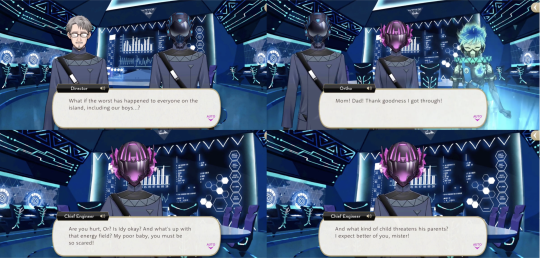
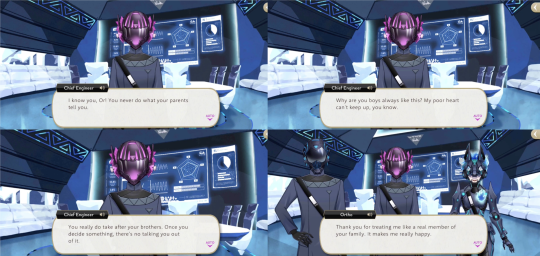
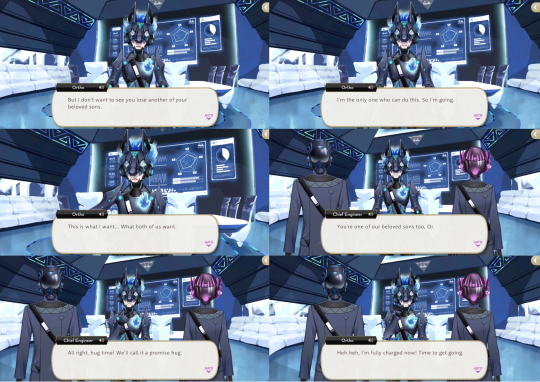
When speaking to Ortho the Chief Engineer says, “You really do take after your brothers,” so Idia’s parents may have adopted robot-Ortho into their family as a third son rather than as a replacement for their second.
Ortho thanks them for treating him like a member of the family and insists that he wants to take on the dangerous mission of infiltrating Malleus’ domain as he doesn’t want them to lose another of their beloved sons (in reference to Idia), saying, “This is what I want…what both of us want,” possibly in reference to both himself and human-Ortho.
The Chief Engineer responds, “You’re one of our beloved sons, too,” and the family shares a promise hug.

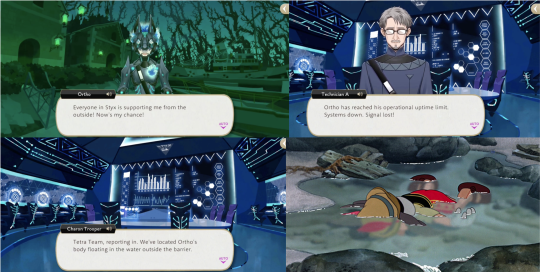
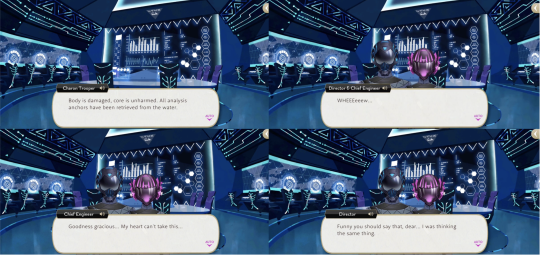
When Malleus starts trying to destroy Ortho his parents respond by putting all the CHARON into termination mode and diverting all energy to their technomantic cannons in order to distract Malleus. When a staff member cautions that they will fry their generators the Director responds, “Do it anyway!”
Ortho manages to escape Malleus’ domain with the data he was sent in to collect and is found with his Cerberus gear floating in the water outside of Malleus’ barrier, possibly in a reference to the original animated Pinnochio movie.
His parents are relieved.
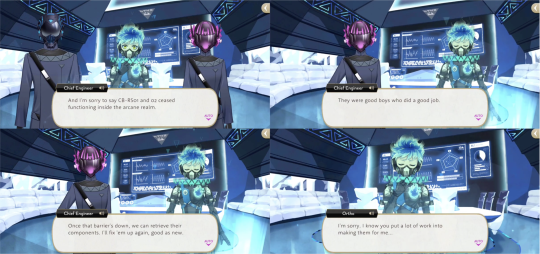
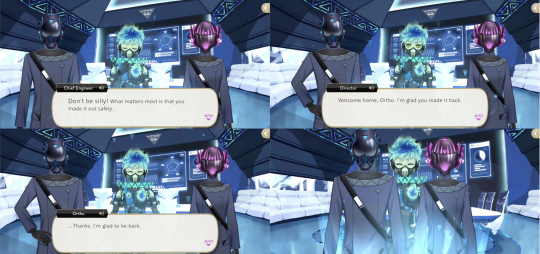
Ortho apologizes for losing the two android dogs that his mother made for him and she responds, “What matters most is that you made it out safely,” saying that she can fix them up again after their components are retrieved. The Director welcomes Ortho home and the family shares another hug.
It is Idia and Ortho’s parents who come up with the idea of making dream-based contact with those within Malleus’ domain to approach Malleus from inside his own worlds: “If we can't do anything from the outside, we have to work from the inside instead.”
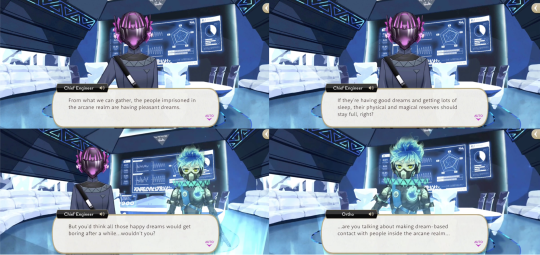
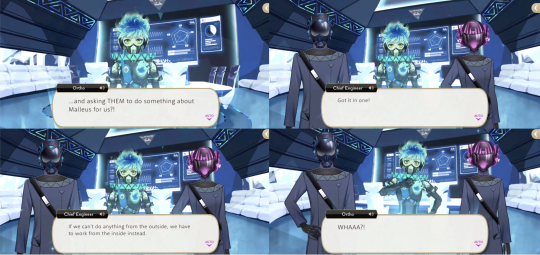
67 notes
·
View notes
Text
I cant do this anymore - George Russell x Wolff! Reader P3
Plot: You are the daughter of Toto Wolff team principle of Mercedes-AMG Petronas, you've worked your whole life to become an engineer. However, your dad has other ideas for you and doesn't want you to become a race engineer. You start to confide more in the Red Bull Racing Team Principle to help you get an engineering job, and see him as your present father figure.



"You ready for our first Grand Prix together Max?" you ask, testing with Max had gone really well and Christian was happy with the dynamic the both of you had. Max as gentle and kind as he was, he was very ambitious and that ambition when it didn't prevail often turned into anger.
Christian saw, in FP1 and FP2 when he didn't think he was performing that well, you just completely calm Max down and talk him through each component of what he needed to improve. He listened to her on took on board when to conserve his tires, when do take turns wider or more sharply etc. And testing couldn't have gone better for Red Bull.
"You know it, lead me to Victory Y/N" he grinned before hopping into the car. You walk over to your station making sure all of the data on the car is looking as good as it did yesterday in qualifying and to check for any errors that could mess Max up in his first few laps. Nothing stuck out, and you could tell that both the car and Max would perform well today.
"Is Y/N here i need to talk to her before the race" you heard through your headphones, you turn seeing George in his racing suit and helmet in hand talking to some of the mechanics.
"Mate, you are a driver. You should be getting in your car for radio check. You cant be in the Red Bull area okay?" he advises, making George look around quickly before huffing and walking away in dissatisfaction.
"Max, Radio Check can you hear me" you ask and get a response immediately.
"Yes, loud and clear! Today will be good!" he exclaims.
And how true he was, you guided him into P1, it was an amazing start to you helping Max win the Championship, Mexico had been an amazing drive for him. He shared a podium with Lewis and Charles. There were a few cameras that caught you and Lewis looking at each other and you giving him a thumbs up.
Media teams were about to have a field day.
"You are amazing Y/N! You know the car so well I bet YOU could be the driver! Those strategies were insane" Max complimented you as he'd taken his helmet off and pulled you into an insanely sweaty hug of thanks for a great first race.
"Oh god, I'm definitely not driver material! Don't tell anyone, but I don't actually have my drivers license" you cringe giggling at him, it was something you'd never needed. Your mum or dad normally drove you around before uni, and once you were there everything was within walking distance. It had just felt pointless.
"No way, you've got to be lying to me" Max laughs, wondering how you'd survived so long without something like that.
"Honestly George or Lewis used to drive me around a lot, when i had to go to the Mercedes HQ back home he'd take me if my parents couldn't! You say a light smile on your face before it turned sour thinking of the mousy brown haired man that had completely lost any trust you had placed in him.
"Lets not think about them. Lets talk about you coming with me, Christian, Geri, Kelly, Sergio, Hugh and Carola?" he asks and a massive grin comes onto your face.
"I'm invited to the Horner dinner, huh? That sounds kinda important and fancy. I might just have to decline" you joke making Max roll his eyes.
"No, you are joining us and are having fun and getting your mind off Thing one and Thing two" he jokes, you tried to keep a serious face but you really couldn't.
"Anyway, considering the Princess cant drive do you want me to take you back to the hotel?" he asks smiling.
"If that's okay with you!" you smile happily, he nods slinging an arm around your shoulder guiding you to the car.
"So when do I finally get to meet P!" you exclaim, even though you'd only been working with Max for a week, you'd gotten to know him very well. You had to considering he had to trust listening to you while he was driving round a track a 200 miles an hour.
"Hmmmm I think Kelly said she'd be bringing her to the race next week. It's Brazil so its an important one for her!" he admits. The conversation flew between you and Max, it was strange really it felt like you'd been friends with him for ages. You had to grovel when it came to any of the Mercedes Drivers in the past, so this easiness to making friends felt good.
That was one thing you'd struggled with. You had a love for F1 straight away considering who you parents were and where you were constantly travelling from race to race until you got to university age. So you didn't actually have many friends who stuck around.
You both eventually ended up at the hotel, you waved at Kelly who was waiting for the both of you and she pulled you into a big hug as she walked over to you.
"You both did amazing today! So proud of you! Y/N, did Max end up inviting you to dinner tonight!" she exclaims, wanting you to be there as well.
"Yes, I'll be there" you smile and say your goodbye's before dashing into your room to get ready for the dinner.
You struggled on what to wear and ended up calling Max to get Kelly to help you on what the dinner vibe was for tonight. You ended up showing her half the stuff you'd brought to Mexico with you and ended up picking one of your nicer dresses from Versace.
You took some pictures before a knock was heard at your door that had you confused as you were meeting up with Kelly and Max outside theirs in 30 minutes.
You opened the door, and looked up to see who had come to the door.
"Omg" you both said at the same time, you tried to slam the door shit. George wouldn't ruin your night, he didn't deserve too.
However, a foot and arm in the door and his general athletic body that made him stronger than you prevented all of that. He practically barged his way in.
You both stood there in awkward silence. George couldn't get over how beautiful you looked. I mean, you were always beautiful to him. But tonight in the black dress that he swore Donatella had personalized just for you, and the way your hair fell around you face in an effortless fashion. He couldn't look away from you.
"If you've come here to accuse me some more, then just leave. I'm about to have a really good night with friends, people who actually care for me and want me to succeed and if I'm being honest I do not need your negativity" you say, turning around to check yourself in the mirror.
"You look gorgeous tonight. So i wont do this tonight, but please meet me in between the Mercedes and Williams garage next week in Brazil. We need to talk. We've been friends for years and I don't want my stupidity to come between us" he says, stepping towards you going to reach out his hand. You step back, it took a lot especially with this ocean blue puppy eyes looking at you with that sad expression that would make anyone fold.
"Please, After Qually, I'm only asking for five minutes Y/N please" he begs trying to catch your eyes but you were doing your best not to look at them too often, knowing you would probably cave.
"I'll think about it. If I'm there we can talk, if not then its up to you if our friendship is really worth waiting for" you admit, walking to the door and opening it up for him as a sign that he should leave.
"I've waited long enough" he mumbles before walking out the door himself and leaving towards the lift that was down the corridor from your room.
The night had gone so well, you were really beginning to feel comfortable around those in Red Bull. The people at the table were being so kind to you as the newbie, Christian pouring you the water, recommending you dishes he liked whilst arguing with the actual Mexican in the room who knew the cuisine of the restaurant like the back of his hand, to offering you the salt and proceeding to do it for you had your heart melting.
It was stupid, really. You shouldn't be this emotional over an older man doing small silly little tasks that you could tackle alone but just was nice to have the offered help. Help that you hadn't received in recent years.
"I really want to thank you all for tonight, its been really nice to hang out with you. And i cant wait for a double podium in Brazil next week!" you exclaim clinking you glass with everyone around the table.
However, George still managed to creep into your mind thanks to his earlier disturbance.
Would he actually apologise?
Taglist:
@littlesatanicassholebitch @hockey-racing-fubol @laura-naruto-fan1998 @22yuki @simxican @sinofwriting @lewisroscoelove @cmleitora @stupidandunnecessary @clayra-g @daemyratwst @honey-belden @moonypixel @lauralarsen @vader-is-hot @ironcowboycopnickel @itsjustkhaos @the-untamed-soul @beebo86 @happylittlereader @ziejustme @lou-larcher5 @thewulf @purplephantomwolf @chasing-liberosis @chillyleclerc @chanthereader @annoyingmoonballoon @summissss @evieepepi08 @havaneseoger08 @celesteblack08 @gulphulp @fandom1ruined2me @celebstories @starfusionsworld @jspitwall @sierruhh @georgeparisole @dakotatankbig @youcannotcancelquidditch @zzonsbeek @tallbrownhairsarcastic @mellowarcadefun @ourteenagetragedy @otako5811 @countingstacksandpanicattacks @peachiicherries @formulas-bitch @cherry-piee @hopexcroc @mirrorball-6 @spilled-coffee-cup @urdad-hot
Hey guys, so i've noticed some people in the taglist aren't getting tagged, I'm not sure if this is username changes or what... but i will start to take of one that don't link to an actual page, so if you see your account name and its not working please feel free to message me, or comment her or on my masterlist of taglist so i can see your knew username!
#f1 imagine#f1 x reader#formula 1 x you#formula 1#formula one#formula one fanfiction#george russel imagine#george russel x reader#george russell imagine#george russell
473 notes
·
View notes
Text
Legislation under the moniker “right to repair” has now been introduced in all 50 states, marking a major milestone in this grassroots consumer movement.
GNN has reported on the march of right to repair laws across the US, but also the kind of entrepreneurialism they engender: like an aftermarket auto parts company that makes replacements for well-known faulty components in automobiles.
Passed in New York, Minnesota, Colorado, California, and Oregon, Wisconsin just became the final US state to introduce some sort of right to repair laws.
In broad terms, all of these bills would generally guarantee a consumer’s right to access replacement parts for devices and machines, repair manuals or other relevant documents for expensive products, diagnostics data from original manufacturers, and even in some cases, such as automobiles, appropriate tools necessary for maintenance.
They may also ban the use of technological protection measures, sometimes called “software locks” that are designed to restrict repair only to authorized repair technicians.
“Americans are fed up with all the ways in which manufacturers of everything from toasters to tractors frustrate or block repairs, and lawmakers are hearing that frustration and taking action,” Nathan Proctor, right to repair director for consumer rights group PIRG, told 404 Media’s Jason Koebler, who has been tracking right to repair legislation for 10 years.
OF A SIMILAR SPIRIT: 580 Repair Shops Form a Flourishing Subculture Fixing Toasters, Electronics, Coffee Makers and Lamps
He details that at first, big tech and big engineering, such as Apple, John Deere, and others, ardently lobbied against these bills, saying that trade secrets protections would be violated if they were forced to turn over diagnostics, telemetry, or other insider data to non-company actors.
The progressive difficulty with which modern products, particularly electronics, are designed prevents most amateurs from being able to repair them if they break.
MORE RIGHT TO REPAIR NEWS: EU Approves Groundbreaking New ‘Right to Repair’ Laws Requiring Appliances to Be Easier to Fix
Screws are forsaken in favor of plastic locking toggles which break if removed, fuse or wire cover panels are replaced with jointless polymer molded covers, both of which and many more examples besides are designed to deter the fix-it-minded folks enough so that they will just throw the product away and buy a new one.
Electronic waste is one of the largest sources of non-recyclable landfill waste, and hopefully enough of these right to repair bills pass that some of these millions of powerstrips, lamps, phones, computers, and televisions can be kept out of the ground.
76 notes
·
View notes
Text
Krittika Nakshatra "The Star of Insight"

Krittika Nakshatra, often called "The star of insight," is well-known for the unique abilities of its natives. These individuals possess a remarkable talent for breaking down complex ideas into simpler, more understandable components. This skill not only showcases their intellectual capabilities but also reflects their deep understanding of various subjects. Their innate ability to clarify intricate topics allows them to communicate effectively with others, ensuring that even the most complicated information can be grasped by a wider audience. This makes Krittika natives invaluable in academic and professional settings where clarity and comprehension are crucial.
One of the most distinctive traits of Krittika natives is their attention to detail. They have a keen eye for observing nuances that others might miss. This meticulous approach enables them to analyze problems from multiple perspectives and uncover elements that contribute to a more comprehensive understanding of the issue at hand. By applying their analytical skills, these individuals can distinguish essential components from irrelevant information, streamlining complex processes. Their ability to break down tasks into manageable steps allows them to tackle challenging projects and enhances their overall productivity.
Furthermore, Krittika natives thrive in environments that require a systematic and organized approach. Their precise and methodical nature helps them navigate intricate systems with heightened efficiency. This characteristic is particularly beneficial in fields such as research, engineering, and data analysis, where complex information is commonplace. By leveraging their skill in subdividing tasks, they can create strategic plans that lead to successful outcomes. Ultimately, the capabilities of Krittika Nakshatra individuals make them stand out in their fields, where their insights and clarity significantly contribute to collective knowledge and problem-solving efforts.
Return to Basic Stories of the 27 Nakshatras Masterpost
#astrology#vedic astrology#Krittika#Nakshatra#Taurus#Gemini#astrology posts#natal chart#birth chart#astro notes#Sun#astrology tumblr#astrology blog#astrology observations#vedic astro notes#vedic notes#vedic astro observations#vedic astrology observations#Krittika Notes#Krittika Nakshatra#Krittika Insight#Krittika Description#Krittika Knowledge#Nakshatras#Sun Nakshatras#Krittika Meaning#Krittika Star#vedic nakshatras
48 notes
·
View notes
Text
just had to have a conversation with someone today who was whining about how mclaren is only winning because they have the fastest car... like... yeah? that's how f1 works? the driver and car and entire team for that matter cannot be treated as separate entities. every component, every pitstop, every strategy call plays into getting even a single point. yes, this applies to every sport, but more so for f1 because even the smallest of successes cannot be attributed to a single person.
and this works vice versa as well. your favourite driver does not need to be dragging a tractor to pole for them to be a great driver. i don't know why some fans are hell bent on proving this every race.
this post is not anti any driver, or any team. i have great respect for the drivers alluded to in this post, and in fact some of them are my favourites on the grid. but that does not hold much regard in this context. there's just been so much discussion in regards to this lately and i don't know why we as fans, consciously or subconsciously keep trying to separate the driver from the car.
f1 is not just about what happens on track, and it's never been. the wheel to wheel racing is a huge aspect of it, sure, but thousands of people spend years and years observing performances, analysing data, working and reworking components to try and gain even 0.001 seconds. there is constant two-way feedback, team meetings, upgrades, and it takes years of struggle sometimes before you can even reach a position where you fight for points. and not to mention the millions of dollars that go into it. yeah, f1 is extreme on the track, but it's even more extreme off of it. the degree of competition it generates between teams, between engineers, unlocks a level of efficiency simply unheard of anywhere else. that's exactly why the inventions and strategies created in f1 have been applied in multiple fields, be it developing exponentially better energy sources, or improving surgical procedures to save thousands of lives.
is is impressive when a driver with a slower car wins? yes, unarguably so. but is it necessary for that to happen for them to be a great driver or have a great race? no. the fast car is both the cause and the consequence of the drivers and the teams success. it's never something that takes away from it. having the fastest car is a flex. winning in the fastest car is a flex.
#sorry this has just been on my mind lately#also contrary to what it seems here#for the record#i do not support mclaren#and max is one of my favourites on the grid#but its just crazy that having the fastest car suddenly takes away from a drivers talent#when its only an indication of it#f1#formula 1#ferrari formula 1#mclaren formula 1#redbull formula 1#charles leclerc#max verstappen#lando norris#oscar piastri#lewis hamilton#miami gp 2025
38 notes
·
View notes
Text
An Undergraduate Forensic Viewing of Like Minds (2006) Train Scene

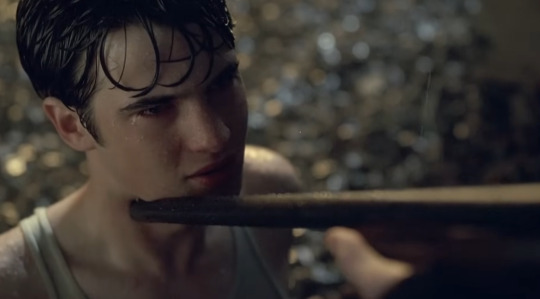
Pray for me. Pray for yourself. We are one now.
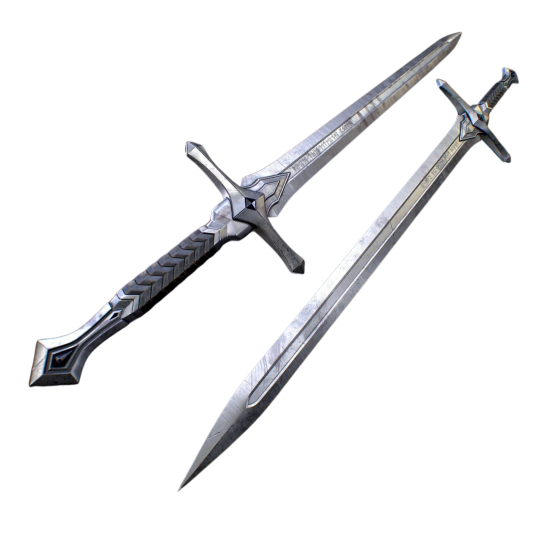
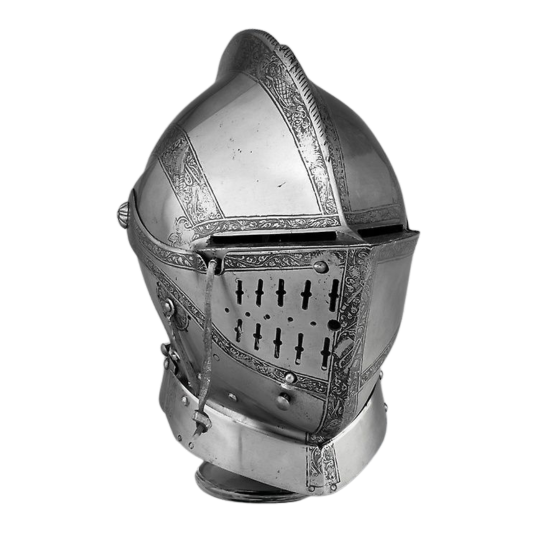

Contents:
1. Introduction 2. What We Know 3. The Investigation 4. Bibliography for Nerds

1. Introduction
Some justifications first.
I'm an undergraduate stem student obssessed with many topics, including forensic studies. I just finished a complete course about forensic chemistry/tecnology/law in uni and yes, I'm a big failure of a person and was thinking about applying some of the things I've learned into Like Minds' train scene. To clarify, I'm not an experienced profissional of the field. It is to say, I've never worked in such area and had just one or two significant interaction with said profissionals and students. My considerations won't be 100% accurate, clearly, and I may mistake or ignore fundamental data and studies. I intend solely to present some interesting facts and rapidly discuss their applicability here.
Take everything I say with large grains of salt, this is mostly for my enjoyment.
Let's kill Nigel!
2. What We Know
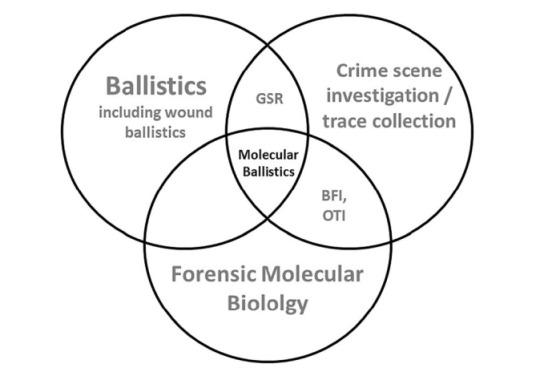
Figure 1. Visual diagram of forensic ballistics' main areas of study. Some will be mentioned here. [1]
2.1. Ballistics - Anatomy of a Discharge
Ballistics is a science field divided in three main ramifications: (1) Interior Ballistics, (2) Exterior Ballistics and (3) Terminal Ballistics. (1) studies the mechanism of a gun discharge, (2) studies the trajectory and behavior of a projectile once it is ejected from a firegun and (3) studies the damage and overall interaction of the projectile with a material structure (biological or not). [1] Ballistics experts (chemists, some engineers, law experts, etc) ocuppy themselves with many things regarding firearms, a field of work that recuries much study and understading of multiple fields of knowledge such as spectroscopy, law and general legislation, physical properties of chemical coumponds, solid state science, material science, industry production series and others. Some areas of chemistry and biology are of great importance and are commonly used complementarily.
We then understand what bullets are. The component that effectivally hits the target in these scenarios is the actual "projectile".
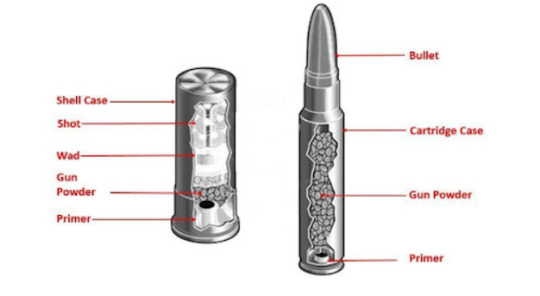
Figure 2. Simple structure of shotgun (left) and rifle (right) ammunition. [2]
In simple terms, they're composed by (1) a shell that holds everything together, (2) some coumpond responsable for the liberation of gas via chemical reaction and (3) some way to give the heat needed for said reaction to occur. There is a whole field of study and production of these killing objects that seeks out to balance some of their properties in different scenarios by the armamentist industry in oder to supply endless applications that constantly develops new shapes and components, so going through it all would be impossible. Regardless, all ammunition is classified by size, called "gauge" in shotguns, and "caliber" in rifles and handguns. [2]
Case: [in shotguns] It is a small cilindrical piece made out of a tube of common plastic or sturdy paper (the red/blue/colored part) that holds the multiple projectiles to be fired (shots), with a metallic base (the primer) composed of brass (copper and zinc) or steel (iron and carbon). [in rifles] The case is called cartridge case, and it is composed by brass as well. [2]
Powder (or propellant): They are usually Nitroclelullose (handguns), Nitroclelullose/Nitrogliceryn (rifles) and Nitroclelullose/Nitrogliceryn/Nitroguanidyn (long range rifles) [3]. Oversimplifying, organic molecules containing nitro groups (present in Nitroclelullose, Nitrogliceryn and Nitroguanidyn) are really unstable; these chemical groupaments are highly reactive in face of many scenarios. If enough energy is provided (by heating, or mechanical contact and pertubation) they will enter a decompostion process, breaking and reacting with their own bonds spontaneously, liberating gases such as H2O, N2 and CO2. These mentioned gases are much more stable compared to the original organic coumponds, so the atoms will "prefer" to form these species if the conditions are set (thus, a spontaneous reaction). This increases pressure inside the shell and forces the projectile to leave violently as a result of gas expansion. [4] Shotgun powder is composed by potassium nitrate, charcoal and sulfur; a mixture known as "dark powder", and it is separated from the shot (projectiles; multiple balls of steel, lead, rubber, or really anything) by a small component called "wad". The same principle explained in the decomposition of organic nitro-compounds apply for the potassium nitrate present here, but only in the presence of sulfur (easier to melt and ignite), providing the necessary heat for potassium citrate to generate the oxygen needed, resulting in charchoal's combustion. [2]
Primer: Primers are a fundamental part of any ammunition, and yet a simple one. When a firing pin from the firegun hits them, sparkles and heat will be produced, which gives the propellent all requiered energy for the chemical reaction. It is, when the action lever is pulled, the firing pin is tensioned by a spring inside the gun. When the trigger is pulled, this firing pin hits rapidly the ammunition's primer (metallic base). [5]
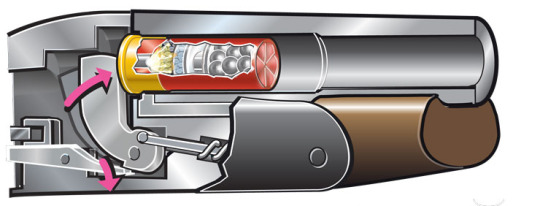
Figure 3. Shotgun firing pin scheme. [5]
The discussion of differents powders/propellents (like smokeless powder), projectiles shapes (in rifle cases) and firegun types (other than rifle and shotgun) is being ignored.
All that must be known is: the trigger pulling promotes a mechanical impact against the ammunition base, which promotes chemical reactions that liberate great amounts of gases, increasing the pressure inside the case, what will pushes the projectile(s) inside foward with great speed.
2.2. The Shotgun - Means to An End
We now restrain ourselfs to the firegun. Let us take a look on the following images:

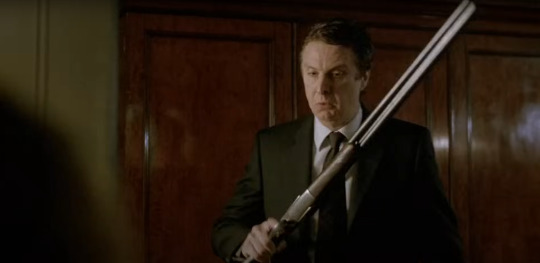

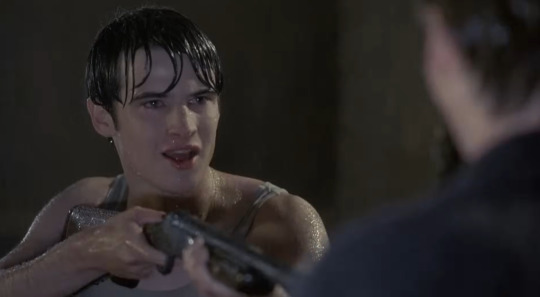

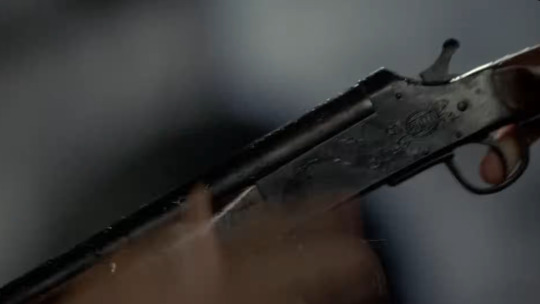
Figures 4-9 (left to right, top to bottom). Shotguns' takes from Like Minds (2006).
Main considerations:
The shotgun used by Mr. Colbie isn't the same one used by Nigel/Alex in the train scene. We can clearly point that by the number of barrels, i.e., two barrels contaning two projectiles (killing Nigel's mother and father without visible activation) in its first appearance, and only a single one in its second appearance. Maybe this has been discussed before.
It is not a narrative problem if we have the eyes for it. Nigel's father possesses two shotguns, so we assume Nigel went back and grabbed the single-barrel one before going after Alex.
The reloading thing would be important during the bedroom scene, between the moments where John shoots his wife and Alex picks up the gun from the floor. There would be no way of aciddentially shooting Mr. Colbie wihout Alex pulling the action on the second barrel (how would he know which one of the barrels were loaded and why Mr. Colbie would only activate one of the two barrels? It appears he wasn't using the shotgun to merely scare his family). Perhaps the double barrel shotgun used has some individual firing feature, perhaps.
Also, the single barrel shotgun is the same one used by John when Alex and Nigel first accessed the hidden baseament together. This isn't of great relevance though.
After a compulsive research in gun sale sites and over 900 models of shotguns (no joking), I'm inclined to believe that Nigel's single barrel shotgun is an Era 410 GA Single Shot Break Action. My conclusions is based on Figures 6 and 9, the shotgun's best takes throughout the entire movie. The important details are: a single barrel, with rounded trigger guard that ends exactly where the wooden stock begins, by a rounded break action lever with squarish shape that leans horizontally to the receiver and a rectangular like forestock. Other smaller details are: the receiver's top shape and really curved back, the declination present on the stock and the three screws' position and size.
The engraved symbols on Colbie's receiver are sculpted by a profssional artist called "engraver", by client's demand. Therefore, these sigils are decorative and probably carry some meaning to the shotgun's real owner, so they aren't a discrepancy to worry about. The frame I acquired (Figure 9) is of poor quality and there's nothing I can read in there besides one or two letters. I've tried to watch the movie in other internet sites but it didn't help that much.
It took me forever, but here it is [6], [7]. There are also youtube videos revewing this gun in the Extra section.

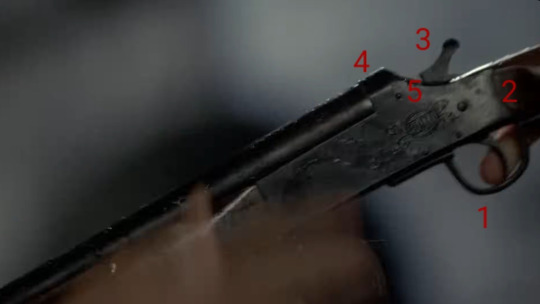


Figures 10-13. Era 410 GA Single Shot Break Action Shotgun. [6]
Note: @laurelwen successfully identified Nigel's firegun as a Boito .410. The text engraved on the shotgun's receiver in Figure 9, in fact, reads "Boito". Check it out on this post. Look up Extra Bibliography No. 7 in the shotgun's section as well.
Shotguns are a really old type of gun from the 16th century. Their mechanisms were adjusted during following centuries, but they remain still to date with an extremely simple way of function. Today, there are many types, including the single-shots and hand shotguns, much different than what was originally conceived. A break shotgun is capable of "breaking in half" for reloading, exposing its ejector/extractor and barrel interior just as many other fireguns. [8]
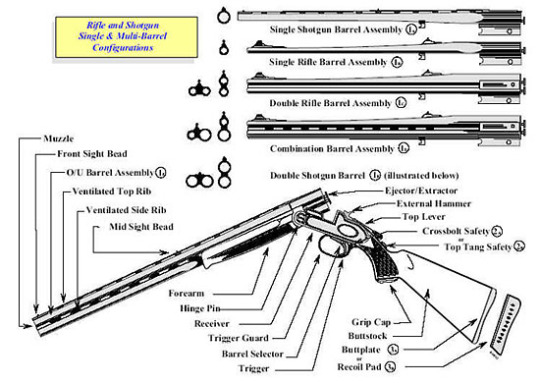
Figure 14. Break action shotgun anatomy. [9]
The Era 410 GA possesses a specially long length of barrel, which helps projectiles to achieve maximum velocity before leaving. Still, it appears from my research that this is a second hand model with low price, low demand and little historical relevance. This is the type of gun that would be bought mainly by collectors and enthusiasts; however, because of its little weight, good shooting and minimalist elegance, this firegun is not one of the worst models out there for small amateur animal hunting.
A 410 (10.41 mm, one smallest shot diameter in the market) with great pattern of dispersion after the discharge isn't bad, so at medium distances most projectiles would succesfully hit the center of a target. This is not very good when we're talking about a point-blank discharge directly at Nigel's face.
3. The Investigation

Figure 15. "If they had any evidence, I wouldn't be talking to you, would I?"
Authorities arrive at the dark, umid and isolated train tracks. Immediatly, a shocking scene: a desperate young man holding in his arms the corpse of a dead boy, disfigured. They transport the living witness away from the scene, but the lying unknown and deformed body is extracted for further autopsy. Detective McKenzie takes over with Forensic Psychiatrist Sally to interrogate the surviving suspect, Alex Forbes.
After the initial approach and first hours of interaction, the case takes an unexpected form. The question now is, did Alex Forbes shoot the now identified Nigel Colbie alone, or did Colbie participated in his own killing to incriminate Alex?
The police wastes its time thinking about common scenarios described in the book. They know the victim, the place where it happened, the exact gun used and the main suspect. Everything comes down to answering the presented question. Psycological attempts of extracting an answer from Alex by closed sessions with Sally, it is, to try and build a thrust and comfort relation with the suspect in order to obtain a confession would be protocol. But Alex clearly is beyond that, and if we must say, he's in control the whole time.
All that is left for the police is to attach towards factual evidences. Now, we describe two fundamental forensic elements of a gun-related crime.
Gunshot Residues (GSRs)
GSRs are one of the strongest evidences when it comes to forensic studies. Being composed of burnt and unburnt organic or inorganic particles from the explosive primer from the shell, propellant and possibly fragments of the bullet, cartridge case, and even the firearm, they frequently contain elements such as Sb (antimony), Ba (barium), Pb (lead) or Zn (zinc), Cu (cooper), and Ti (titanium). Their deposition concentrates away from the firearm into the shooter's (arms, face, hands and chest mainly) and victim's (region of contact mainly) bodies. GSRs can be found in nearby surfaces as well, such as the floor, ceiling, walls, objects, clothes, etc. The direct deposition of these residues must be carefully used as evidence because of its irregular distribution on the surrounding enviroment after the discharge. Thus, the main factors are always the chemical composition and concentration spots. Shotgun shots (the small spherical projectiles) are usually made up of lead or lead/antimony, but some ammunitions use steel, zinc-plated steel, tungsten and bismut in substitution (So, in our case, we can expect more significant ammounts of antimony/lead or zinc, iron and carbon). [10], [11]
A 410 ammunition is classified as "birdshots" ammunition, used for hunting said animals. The little diameter of projectiles allows the carrying of multiple projectiles inside one shell, facilitating the execution of small moving targets. The potential damage mustn't be underrated, though.
The aforementioned substances/elements can be detected, investigated, and quantified using microscopy, chemical analytical and chemometric methods, such as Scanning Electron Microscopy (SEM), Energy Dispersive X-Ray Spectroscopy (EDS), Atomic Absorption Spectroscopy (AAS) and Energy Dispersive X-Ray Fluorescence (EDXRF). All these techniques are extensively known and applied in uncountable areas of science for identification and characterization of solid materials. In a nutshell, these methods revolve around the interaction of matter with radiation (such as X-Rays) and the energy absorved/emitted by it after the interaction. The SEM is a most usefull analysis for it can provide real images of micro structures and particles present above any surface, like clothings, skin, fifregun metal and others, if properly prepared. [10]
It is important to understand that these identification methods are of extreme precision and sensibility, it is, minimal concentrations can and will be detected inneviatbly.
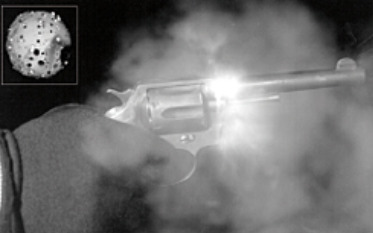
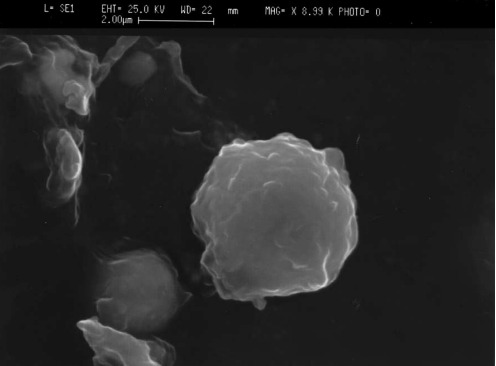
Figure 16 and 17. (Left) Image of gunshot powder residues dispersed in the air after discharge. Top left and (Right) images refer to SEM "photos" of extremely small particles of GSRs that can be chemically analyzed. [12], [13]
What about the lifespan of these residues? In long terms, the shooter's trigger hand (right hand) seems to contain most of the residues that persist for a fair amount of time after the discharge. [10] Unffortunately, the mentioned study occured in controlled enviroments, which is not the case. Another work [14] concludes that most GSRs are lost after two-four hours from the discharge. Considering the fast action from authorities described in the movie, we can basically ignore this factor and consider other variables.
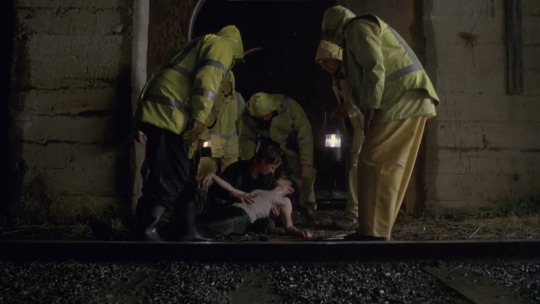
Figure 18. "All I can tell you, was that the heavens were falling. And the sound... it was incredible. It was like the Gods were rejoicing for what was done."
Backspatter Material (BM)

Figure 19. Distribution of Forward Spatter and Backspatter caused by a shot at a biological target. [1]
We hereby exclude the forward spatter, it is, the biological material projected fowards with the projectile (to the back of Nigel's head), for its little relevance, since we're not questioning the type of gun or ammunition used; we assume that Alex is describing a resonable scenario that matches with the actual damage done to Nigel. There are no consistent reasons to question this since everythings seems to support Alex's description of this.
BM comes from the combined forces of several interacting wound and ballistics effects. The collapse of the wound cavity and balance of resulting overpressure, the stream of liquid and tissue particles accelerated along the lateral surface of the projectile, the shot's contact and ejection of muzzle gases out of the entry wound from the powder cavity... Every surrouding surface must be investigated, that is, even the shotgun barrel's interior. This small ambience is fairly protected from external pertubations and houses BM from the shot. Considering the poximity with Nigel's face, we can almost assure to encounter biological material with DNA inside. The bellow mentioned study cites another work where a 9 mm pistol cointaned backspatter material from test targets even at a distance larger than 1 meter, much greater then the few inches that separated Nigel's face from the barrel. [1]
Matter of fact, this biological material can pass by processes of Organ Tissue Identification (OTI) and Body Fluid Identification (BFI) if Nigel's identity was at question, or if we desire to understand more profundly the projectile's damage caused to his skull/face/tissue. [1]
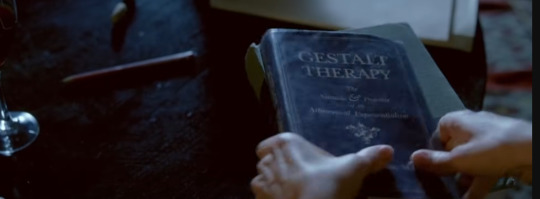
Figure 20. "None of what I've heard makes him a murderer."
So, how can we gather this up to develop the investigation? Utilizing only these two fundamental concepts, we can make a few assumptions.
The big question here is if whether or not Nigel's hands were present by Alex's when the trigger was pulled, which would lead the police to support or oppose Alex's narrative. Chemical examination with organic solvents (which won't cause preocupant harm to a dead body) and analytical methods could immediatly point to the presence of GSRs or biological/non biological BM. If Nigel's hands were elevated in his head level (or superior) in the instant of discharge, trace amounts of discussed metals/elements coming from the firing mechanism and ammunition, as weel as little to some biological material, would definetly be found in his hands and forearm skin since there was no clothing covering. Any substance found in his hands/forearm could be microanalytical compared to the ones present in Alex's hands, clothes and face as well. This could be done with really small samples of fresh skin. On the other hand, if Nigel's arms were lowered at the instant of discharge, we could still expect the presence of GSRs in his arms (yet, in less amounts) but the abssence of backspatter materials most certantly. This would classify Alex as a murderer without excuses, even if he alleged that Nigel asked for it.
In the scenario where Alex discharges at Nigel from a great distance (configuring simply murder) we could note the abssence of GSRs in every part of Nigel's body except for the targeted region (perhaps if they were at a greater distance to each other) and the presence of these GSRs in Alex, but in much higher concentration.
But the enviromnent's conditions are of primordial importance. Nigel and Alex stand in an open area, with considerable wind, heavy rain and gravel soil. The heavy rain could simply carry way much of these residues from Alex's body, clothes and Nigel's hands as well. Most GSR would probably be lost to those conditions and its deposite upon the soil's surface would be extremely hard to be quantitatively analized due to unknown degrees (elevated) of impurities and diverse materials and dirt present, but qualitative tests would still be valid.

The knowledge about the victim, crime scene, shooter, exact firegun and time of the tragic event allied with the fast action from authorities saves most of the police's efforts on identifiying and tracking down evidences. However, what remains still offers a challenge. The best evidence here, GSRs left by the discharge, would be of questionable help considering the presence of heavy rain in sight. Still, analitical quantities of them, if detected in Nigel's skin by proper chemical and espectroscopy-related analysis, can be used to comparate probable ammounts present in Alex's clothing and skin (despite the difficult of such). With that being said, the police would find themselves in a much more complex case of muder/assisted suicide, and further evidences and information about their relationship and recent whereabouts would ineviatably need to be extracted from external sources (such as parents, school's employess, close friends and students). Despite all this, Alex's final acting of removing Susan's body and disapearing from sight (not to mention the card left in Sally's car) immediatly sustent his guilt in a case where he already was the main suspect and basically confirmed criminal. And you know, breaking into a cemetery and extracting a corpse from its grave is definetly worth of some jail time. The Colbie's House Murder would certainly incriminate Alex for homicide as well, and the current Brotherhood's little political influence wouldn't prevent him from this destiny, as it appears. But the case is not over.
Further evidences were to be discussed, if it was not for the dissapearing of Alex Forbes.
The subject now roams unknowingly through England with mysterious intents. Its participation on the described case still lacks formal arguments and the Court should now approve his arrest warrant and search decree. Alex Forbes will most probably live to perpetrate the deluded fantasy responsable for the death of three young students in order to carry the sacred holy burden of an ancient templar bloodline.
Yet, we pray.


Who's the enemy now? We are.
4. Bibliography
[1] Euteneuer J, Courts C. Ten years of molecular ballistics-a review and a field guide. Int J Legal Med. 2021 Jul;135(4):1121-1136. doi: 10.1007/s00414-021-02523-0. Epub 2021 Feb 16. PMID: 33594457; PMCID: PMC8205864. [2] https://spotterup.com/how-ammo-works/ [3] Serol, M.; Ahmad, S.M.; Quintas, A.; Família, C. Chemical Analysis of Gunpowder and Gunshot Residues. Molecules 2023, 28, 5550. https://doi.org/10.3390/molecules28145550 [4] Guanchao Lan, Jing Li, Guangyuan Zhang, Jian Ruan, Zhiyan Lu, Shaohua Jin, Duanlin Cao, Jianlong Wang, Thermal decomposition mechanism study of 3-nitro-1,2,4-triazol-5-one (NTO): Combined TG-FTIR-MS techniques and ReaxFF reactive molecular dynamics simulations, Fuel, Volume 295, 2021, 120655, ISSN 0016-2361, https://doi.org/10.1016/j.fuel.2021.120655. [5] https://www.hunter-ed.com/national/studyGuide/How-the-Shotgun-Shoots/201099_92815/ [6] https://www.invaluable.com/auction-lot/era-410-ga-single-shot-break-action-shotgun-131-c-8284a72a5b [7] https://firearmland.com/item/1079096107 [8] https://www.letsgoshooting.org/resources/articles/shotgun/meet-the-shotgun/ [9] https://www.atf.gov/firearms/firearms-guides-importation-verification-firearms-ammunition-and-implements-war-top-break [10] Virginie Redouté Minzière, Céline Weyermann, Organic and inorganic gunshot residues on the hands, forearms, face, and nostrils of shooters 30 min after a discharge. Science & Justice, Volume 64, Issue 5, 2024, Pages 557-571, ISSN 1355-0306, https://doi.org/10.1016/j.scijus.2024.08.002. [11] Joshua Hallett, Michael Stolk, Michael Cook, K. Paul Kirkbride, Examination of gunshot residue arising from shotgun cartridges containing steel, bismuth or tungsten pellets. Forensic Science International, Volume 306, 2020, 110096, ISSN 0379-0738, https://doi.org/10.1016/j.forsciint.2019.110096. [12] https://www.bka.de/EN/OurTasks/SupportOfInvestigationAndPrevention/ForensicScience/PhysicalEvidence/Homicide/GunshotResidue/gunshotresidue_node.html [13] Francesco Saverio Romolo, Pierre Margot, Identification of gunshot residue: a critical review. Forensic Science International, Volume 119, Issue 2, 2001, Pages 195-211, ISSN 0379-0738, https://doi.org/10.1016/S0379-0738(00)00428-X. [14] Jalanti, T & Henchoz, P & Gallusser, Alain & Bonfanti, M.S.. (1999). The persistence of gunshot residue on shooters’ hands. Science & justice : journal of the Forensic Science Society. 39. 48-52. 10.1016/S1355-0306(99)72014-9.
Extra
random materials, take a look
1. Chemistry of Explosives (book pdf) https://link.springer.com/chapter/10.1007/978-1-4612-0589-0_5 2. ERA 410 GA video 1 https://www.youtube.com/watch?v=lGWm2aaWVAc&ab_channel=SteadFastCourage 3. ERA 410 GA video 2 https://www.youtube.com/watch?v=2S16C5Y6lxY&ab_channel=esquad540 4. Quick discussion about Smokeless Powder on r/guns https://www.reddit.com/r/guns/comments/1tawwm/things_i_want_you_to_know_about_smokeless_powder/#:~:text=Because%20of%20something%20called%20oxygen,and%20temperatures%2C%20leading%20to%20fouling. 5. A little on the kinetic energy of specific projectiles (everything applies here as well) https://nodoroc.com/d/node/20 6. A little more on ammunition Caliber https://www.globalsecurity.org/military/systems/munitions/bullets2-types.htm#google_vignette
For the sake of archieving, here are some shotguns I've separated to double check during my research until the Era 410 GA appeared. Curious enough, number 7, called "boito", appears to be another common name given to Era 410. Woops.
1. https://www.bidsquare.com/online-auctions/north-american-auction/victor-break-action-single-shot-12-ga-shotgun-4988316 2. https://www.crescentcityauctiongallery.com/auction-lot/stevens-arms-.410-gauge-single-shot-break-open-sh_9F84899825 3. https://palmettostatearmory.com/jts-shotguns-single-shot-410-bore-26-single-shot2.html 4. https://en.wikipedia.org/wiki/File:Stoeger-Coach-Gun.jpg 5. https://www.gunsinternational.com/guns-for-sale-online/shotguns/harrington-richardson-shotguns/h-r-bay-state-20-ga.cfm?gun_id=103017190 6. https://www.bankstowngunshop.com.au/product/12g-unknown-model-unknown-single-barrel-blued-wood-28-barrel-poor-condition/ 7. https://www.bankstowngunshop.com.au/product/410-boito-model-reuna-28-single-barrel-blued-timber-3-chamber-sec9622/ 8. https://www.bankstowngunshop.com.au/product/12g-harrington-richardson-model-1908-single-32-barrel-blued-wood/ 9. https://www.bankstowngunshop.com.au/product/12g-norinco-model-std-single-barrel-30-shotgun-great-condition/1 0. https://www.bankstowngunshop.com.au/product/12g-raick-freres-model-unknown-single-barrel-30-shotgun-belgium/ 11. https://gritrsports.com/henry-repeating-arms-single-shot-12ga-shotgun-h015-12 12. https://www.tmguns.co.uk/store/p1418/Tomas_Agote%2C_Eibar_12G_single_hammer_ejector_shotgun.html 13. https://www.tmguns.co.uk/store/p1659/Vanguard_Game%2FVermin_.410_hammer_ejector_single_barrel.html 14. https://www.tmguns.co.uk/store/p1290/Astra_Ciclope_12G_single_barrel_hammergun.html 15. https://www.tmguns.co.uk/store/p1883/Rossi_Game%2FVermin_20G_single_hammer_ejector_shotgun.html 16. https://en.wikipedia.org/wiki/File:Stevens_511_Shotgun.jpg 17. https://www.gunsinternational.com/guns-for-sale-online/shotguns/harrington-richardson-shotguns/harrington-richardson-44-smoothbore.cfm?gun_id=102901609
thank you for reading

#like minds#murderous intent#nigel colbie x alex forbes#nigel colbie#alex forbes#forensic science#analysis#Spotify
26 notes
·
View notes